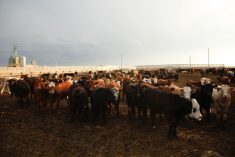MarketsFarm — Despite recent declines in canola prices, the Canadian oilseed remains very well supported, according to Errol Anderson of Market Place Communications in Calgary.
The question he posed, though, was for how long can this last?
“The market is incredibly well supported because of the lack of deliveries and that the crushers are still making money,” he said.
“Should there be a possibility that if the buyer can’t get the canola, then there’s a possibility they might stand in for delivery against the futures.”
Read Also

Alberta crop conditions improve: report
Varied precipitation and warm temperatures were generally beneficial for crop development across Alberta during the week ended July 8, according to the latest provincial crop report released July 11.
The January supply and demand report from Agriculture and Agri-Food Canada (AAFC) kept the department’s December estimate of 2020-21 canola ending stocks at 1.2 million tonnes —which is significantly lower than those for 2019-20. Looking into 2021-22, AAFC reduced its estimate of those ending stocks to one million tonnes.
On the flipside, Anderson noted Malaysian palm oil futures dropped five per cent over a 24-hour period on Feb. 2 and 3 — the reason being India, one of the world’s largest importers of palm oil, recently imposed a tax on its palm oil imports.
Another factor was China and what could be its waning demand. The analyst said corn futures in China have pulled back, which could signal a wider move downward by spilling over into other commodities. However, tight supplies in edible oils still loom across the world.
“When supplies are this tight and the demand is this high, the purpose of the market is to get prices high enough to ration demand,” Anderson said.
Of the edible oils, he said, canola is probably the most solid, pointing to crushers who are still making money.
“The day that goes away, we can really drop,” he said. “Big steps, like $50 steps, because canola is so technically overbought.”
With Brazil’s soybean harvest to hit the market in the coming weeks, he said China could very easily switch its purchases from the U.S. to Brazil.
“And down we go,” the analyst said.
The latest reports pegged Brazil’s crop, which was five per cent harvested, at a record 133 million tonnes. Argentina’s soybean harvest, which remains several weeks away, is expected to be a hefty 48 million tonnes.
Transport strikes in both countries will likely impede some shipments, but the vast majority of those soybeans will get on ships bound for China and elsewhere.
Although ICE canola futures have contracted somewhat, Anderson remained amazed at the gains made in canola.
“I never dreamt canola would be this high, for this long. This is really unusual, but the market is always right,” he said.
— Glen Hallick reports for MarketsFarm from Winnipeg.














